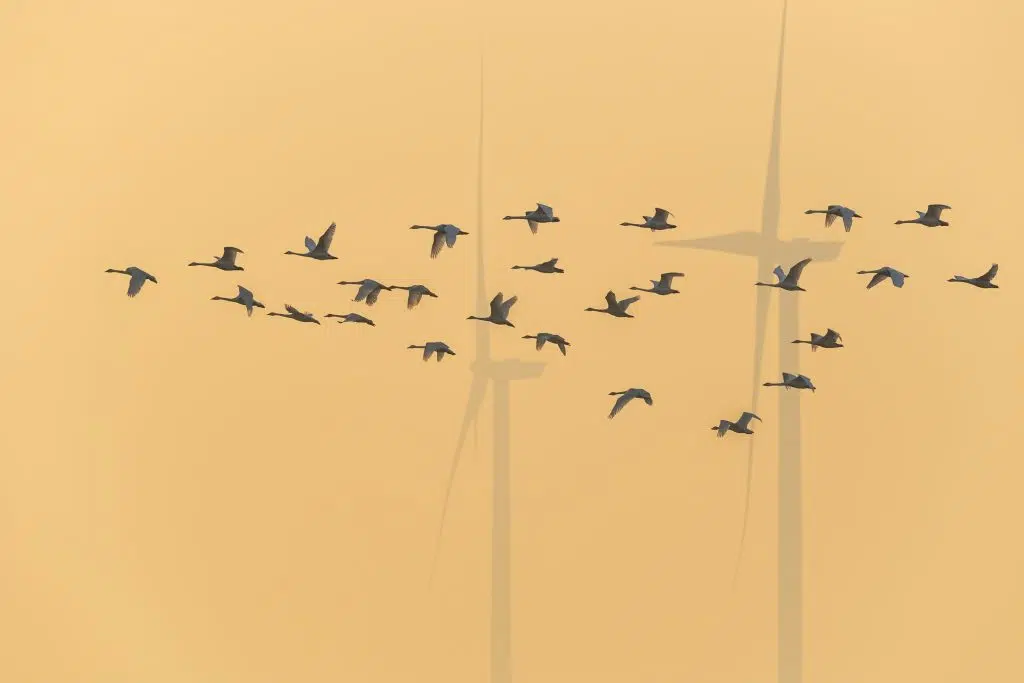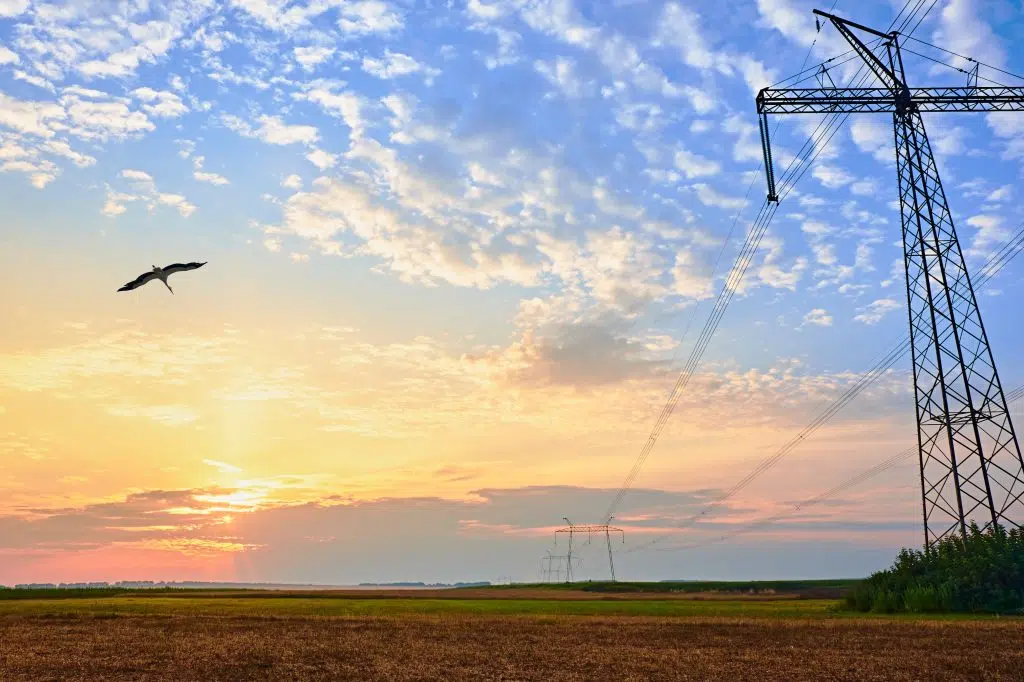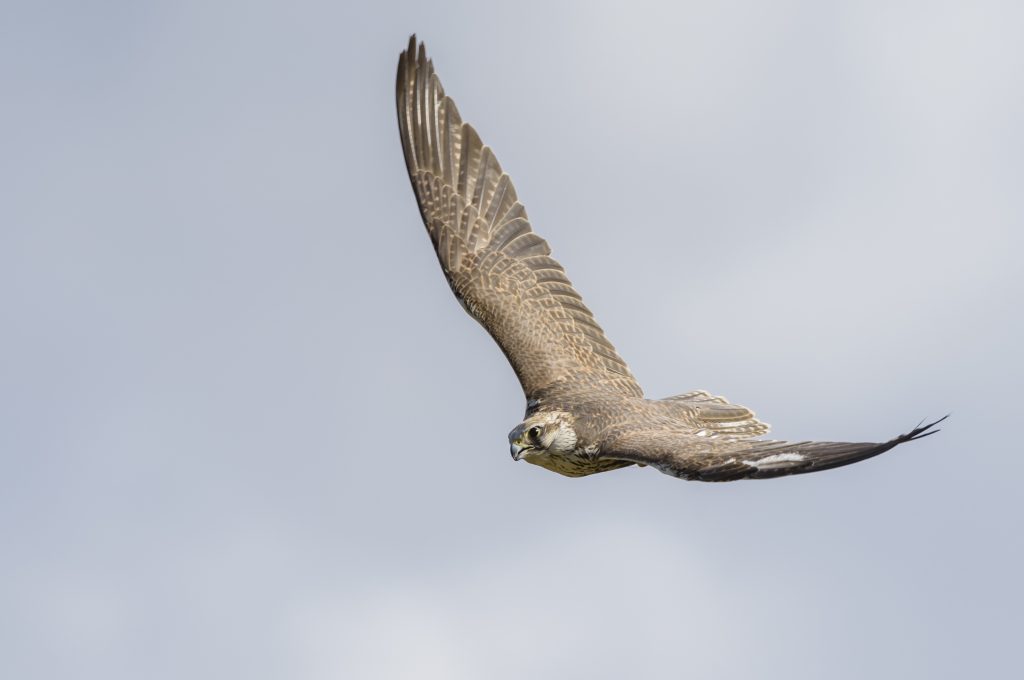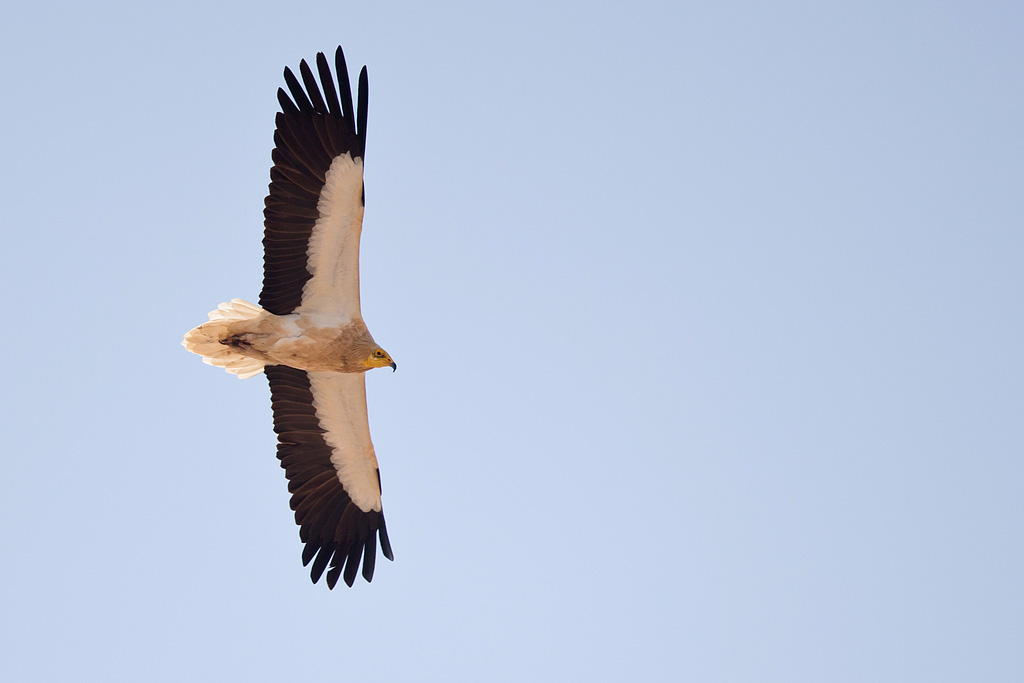Online Tool Prevents Bird Collisions in Flyways Across the World

Today, BirdLife and DEG Impulse launched AVISTEP in four new countries- Egypt, Kenya, Laos and Uzbekistan. Read on to find out how this helps the planet's migratory birds.
Every time we turn on our lights, electrical pulses make their way into our homes through barely visible wires that criss-cross our skies, threatening some of our most majestic soaring birds. But this doesn’t have to be the reality for our planet’s migratory birds.
Just five days before the start of Climate Week NYC, BirdLife International, supported by DEG Impulse, a subsidiary of the German Development Finance Institution DEG, has rolled out AVISTEP, an energy planning tool, in four new countries including Egypt, Kenya, Laos and Uzbekistan. This open-access tool, which has been in use in India, Nepal, Thailand and Vietnam since 2022, helps developers and regulators identify areas where renewable energy infrastructure could impact birds. Equipped with this information, they can then ensure that facilities are developed in the most appropriate locations.
From floods in Poland, to droughts in the Amazon, the world is now at a tipping point for climate disasters. Simultaneously, the planet is facing an interlinked biodiversity crisis. It’s clear that a swift transition to renewable energy is vital.
However, if renewable energy is sited solely to maximize energy production, then millions of hectares of nature could be lost globally. This could impact the ranges of many hundreds of threatened species. The resulting loss of natural habitat would release almost 415 million tons of stored carbon, massively undermining the climate change benefits associated with a transition to renewable energy.
BirdLife’s Tris Allinson, who has led the development of AVISTEP, notes, “renewable energy is not truly ‘green’ unless efforts have been made to limit negative repercussions for biodiversity”.
Across the major flyways of the world, BirdLife and our partners have witnessed the threats that energy infrastructure poses to these birds. Each of the newly added countries – Egypt, Kenya, Laos and Uzbekistan – are experiencing rapidly expanding energy infrastructure, and have significant populations of potentially sensitive bird species.
Central Asian Flyway species at risk
In Uzbekistan, BirdLife partner Uzbekistan Society for the Protection of Birds (UzSPB) has worked to survey the Central Asian Flyway species that could be impacted by poorly placed renewables. Here, powerlines pose a major threat to bustards, while turbines impact raptors like the Steppe Eagle and Egyptian Vulture.
“Large soaring birds are extremely vulnerable to human-made structures through collision and electrocution. The latter is the major cause of death in Saker Falcon and the other 45 raptor species that migrate across the Himalayas.” – David Callahan, ‘From Mountains to Mangroves’, BirdLife Flyways Magazine
Ensuring the safety of migratory soaring birds in the African Eurasian Flyway
With their proximity to the Red Sea and Great Rift Valley, both Egypt and Kenya are important countries for tens of thousands of migratory soaring birds. Surrounded by bodies of water that are difficult for birds to cross, this area becomes a bottleneck for soaring birds that are avoiding the cold winters of Northern Europe and Asia by traveling to the African continent.
“Soaring birds minimise effort by moving slowly- a behaviour that leaves them vulnerable to hunting and collisions with power lines and wind turbines. As species near the apex of their ecosystems, any declines have a severe knock-on effect on other animals, plants and habitats” – David Callahan, ‘Flight Lines’, BirdLife Flyways Magazine
Vultures and other raptors already face threats of poisoning and hunting along their passage, so being able to minimise the threat of energy infrastructure will improve the outlook of these birds in the long term. Nature Conservation Egypt (BirdLife in Egypt), and NatureKenya (BirdLife in Kenya) have both been instrumental in providing the data necessary to address this issue using the AVISTEP platform.
Protecting storks in the East Asian-Australasian Flyway
As a landlocked country outlined by the mighty Mekong River, the type of renewable energy that is expanding most rapidly in Laos is hydropower. While the migratory birds may not face the threat of collision with these riverine structures, the birds may collide with the many power lines that emanate from them to the neighbouring countries. Many storks, like the Asian Openbill, cross these landscapes during their migrations. AVISTEP is intended to keep their migration routes clear from new power lines and prevent these birds from being electrocuted.
AVISTEP allows anyone interested in planning on and offshore wind energy, solar energy, or powerlines, see the exact impact upon species across the entirety of each country. By zooming into a specific region, the user can see a green/amber/red colour coded map that shows whether an 5×5 km area is protected, contains high-risk species, or has wildlife rich habitat. Through the straightforward tool, the user can then easily share their findings as a pdf.
AVISTEP is now publicly available for use in Egypt, India, Kenya, Laos, Nepal, Thailand, Uzbekistan and Vietnam, and will be expanding to more countries in the near future. You can check it out now at AviStep- BirdLife International.
To read more passages from the special Flyways edition of the BirdLife Magazine, click here.






AFRICAN-EURASIAN FLYWAY
One of the world’s greatest flyways, the African-Eurasian flyway links cultures, landscapes and people across the great continents of Africa, Europe and Asia. With three major routes from the Artic to Southern Africa, the birds on this flyway are some of the most persecuted on the planet, with at least 10% threatened with extinction. BirdLife International and its partners throughout the region are working tirelessly to combat major threats including the illegal killing of birds, collisions with energy infrastructure and habitat loss.
Hero Species
Introducing the White Stork: Known as the bringer of life, hope and good fortune, these majestic birds love people and create huge nests on trees, poles or rooftops! After this painstaking effort, these birds make sure to return to their nests every year. White Storks are no stranger to the dangers on this flyway, affected over the past decade by habitat loss, collisions with power lines, and hunting.
500+
Species
100+
Countries
50+
BirdLife Partners

CENTRAL ASIAN FLYWAY
Although it’s the shortest of the world’s flyways, the Central Asia flyway is used by more than 600 migratory bird species. It also covers 30 countries, ranging from the cold of Siberia in the north to the tropical islands of the Maldives – some birds migrating in this area cross the mighty Himalayas many times throughout their lifetime! More than 48 species that use the Central Asian Flyway are globally threatened and 40% are in decline. BirdLife Partners in the region work together to provide safe havens for migratory species, fighting the impacts of hunting, habitat degradation, human disturbance and climate change.
Hero Species
With striking black stripes and a bright yellow beak, the Bar-headed Goose is an impressive migratory bird! Between 97,000-118,000 Bar-headed Geese cross the Himalayas (including over Mount Everest) several times throughout their lives. They have special physical adaptations to survive this incredible altitude and choose specific times of day to fly when the air is cooler and denser.
600+
Species
30+
Countries
8
BirdLife Partners

EAST ASIAN-AUSTRALASIAN FLYWAY
The East Asian-Australasian Flyway is the most densely populated flyway in the world, supporting almost 2 billion people! It also incredibly species-rich with 600 bird species traversing across its 37 countries from Alaska to Southeast Asia, Australia and New Zealand. BirdLife International’s Flyways Initiative with the Asian Development Bank will mobilise $3 billion to protect 50 priority wetland sites within the zone, benefitting both the migratory birds and nearly 200 million people who rely on these ecosystems for their livelihoods.
Hero Species
Although the East Asian-Australasian Flyway hosts a huge array of birds, you can also find some of the most endangered birds in the world on this unique flyway. The Spoon-billed Sandpiper is a gorgeous wader, so named for its uniquely shaped beak specially designed for feeding on marine invertebrates! Despite being less than 800 spoon-billed sand pipers left in the world, a huge conservation effort to save them is underway so there is still hope yet for spoonie!
600+
Species
37
Countries
15+
BirdLife Partners
AMERICAS FLYWAY
The Americas Flyway is the most species-rich in the world, impressively hosting over 2000 different bird species! Spanning the continent from Tierra del Fuego in Southern Argentina to the Arctic Circle in the North, the Americas Flyway contains three migratory routes that cross 35 countries. 90 species on this flyway are globally threatened. BirdLife International is working with Audubon (BirdLife Partner in the USA) and CAF (The Development Bank of Latin America) to pioneer blended financing to protect vast areas across the flyway. The Americas Flyway initiative will mobilise funding to protect 30 sites across the migration routes, protecting birds, their habitats and the people who depend on them.
Hero Species
The Rufous Hummingbird is a small but mighty migrant! At just 3 inches long, this brightly coloured bird flies over 3000 miles on their migration journey! They also have a fantastic memory, remembering where to find food even one year later, and are fiercely territorial fighting off larger species that venture too close.
2000+
Species
35
Countries
14+
BirdLife Partners
